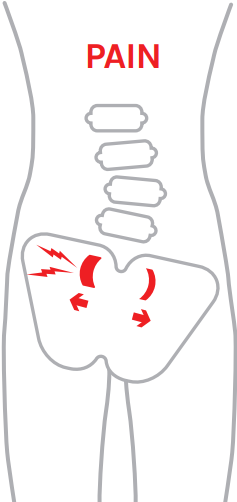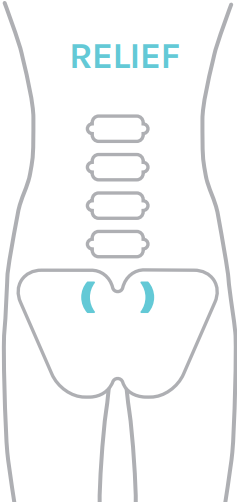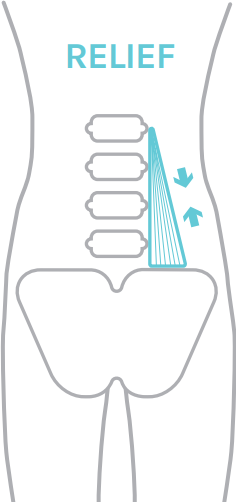
Pelvipro inventor and trained physiotherapist Chris Aldred has years of experience helping patients avoid lower back pain and recover from it. And it was this experience that provided the impetus for him to develop and refine the treatment to benefit as many people as possible.
Here’s his advice on what to do if you experience back pain, and what measures you could take to prevent it from happening in the first place. We’ll also highlight areas where the Pelvipro could be effective in helping to tackle back pain or strengthen the muscles and ligaments in the back to prevent pain occurring.
Keep active
Exercise and activity of any kind are important for many reasons, from controlling weight and lowering the risk of heart disease, to improving social lives and reducing loneliness. When it comes to your back, exercise helps strengthen it and keep it flexible. Use of the Pelvipro in a warm-up routine before pilates, yoga, sport or exercise can also help create a safe environment to strengthen and stretch muscles, and makes sure the muscles you are exercising work at their best. If you need help identifying the right exercises for you, one of our accredited Pelvipro physiotherapists will be able to help.
Sleep well
It’s long been known that good quality sleep is vital for a healthy body and mind but many back pain sufferers experience disturbed sleep patterns. Many sufferers blame their mattress for causing their back pain or making it worse, and this is partly because they feel the pain when they wake up in the morning. But most of the time this is more to do with the body having been mostly still throughout the night, which can cause joints to stiffen and muscles to tighten. In trials of Pelvipro, 90% of patients reported an improvement in their sleeping and judged the quality of sleep to be improved by 66%.
Let’s twist again!
Bending, twisting, lifting and carrying are part of life. Whether it’s reaching into the back seat of a car from the driver’s seat to get something, picking up young children or doing the gardening, we all bend, lift, carry and twist a lot more than we realise. These types of movement potential can lead to Pelvic Motion Dysfunction (PMD) which causes consequential stress on muscles and ligaments. When the pelvis is asymmetrical, up to 150 muscles and ligaments may be affected. So not only is it important to learn the safest ways to bend, lift, carry and twist, it’s also useful to have a Pelvipro to hand, to ensure the skeletal system is in its optimal position to accept load before carrying out a task or to help alleviate pain.
Don’t fear the pain
Your back is actually much stronger than you may think; after all, it needs to be pretty strong to allow us to do all the things we want to do. The bony structures are supported by a range of muscles and ligaments and it is stress on these that causes the pain. People can recover without treatment but a likely underlying cause might be an asymmetry of the pelvic movement which is indicative of PMD and this was a common factor in many of Chris’s patients. Indeed, this asymmetry was so marked that it formed the basis of the Pelvipro’s function: to realign the pelvis.
Whatever the cause, all sufferers would prefer to be pain free. They hate the thought that at any time their back pain might recur, and this fear causes stress. We are complex beings and physical, psychological, lifestyle and social factors may all trigger the sensation and fear of pain. In trials, 71% of patients said their level of stress about back pain had reduced by more than half through using Pelvipro. That’s because, not only does the device minimise the incidence and impact of repeat episodes, but it also puts the sufferer in control of their own pain management.
Find the root cause
Painkillers, lotions and muscle rubs reduce pain temporarily but do not cure the cause of the pain. With 97 per cent of back pain cases caused by musculoskeletal (MSK) problems, the best way to speed recovery is to get to the root of the problem and do the exercise that will do you most good. The Pelvipro has been designed to treat MSK-related back pain: it can create a safe environment to strengthen muscles as well as realigning the pelvis. In trials, 79% of patients experienced instant relief more than 50% of the times the Pelvipro was used.
The patient who was the main inspiration to Chris in developing the Pelvipro had already had scans, surgery, multiple GP and physiotherapy consultations as well as seven years use of NSAID medication. Within six consultations using manual therapy as a precursor to the Pelvipro, she was asymptomatic.

Live your life
Life is for living and the sooner you can get back to doing what you want and need to do, the better. It can be difficult if you are in pain and waiting for a GP or physio appointment to do these things. Patients who have used the Pelvipro at home, at work, on holiday and even on a golf course love the ability to do the quick and easy exercises which enable them to ‘resume normal activities’ while waiting for someone to help them. In trials, 92% of patients said they attributed more than 50% of their improvement to the Pelvipro.
For more information about back pain, the Chartered Society of Physiotherapists (CSP) has recently published this brilliant guide. It gives some great advice on tackling back pain as well as what you can do to minimise the risk of it occurring in the first place.















